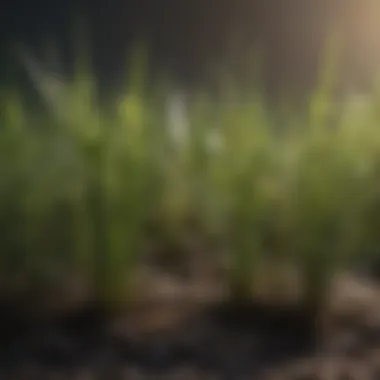Understanding the Timeline for Grass Seed Germination


Intro
Establishing a lush lawn begins with understanding the germination period of new grass seed. This timeframe is crucial for a successful lawn. Several factors come into play, including the type of seed used, the weather conditions, and the maintenance practices adopted by the homeowner. If one has these elements in mind, the path to a vibrant lawn becomes more straightforward.
Grass seeds require specific circumstances to sprout effectively. Understanding these variables can lead to better decisions regarding seed selection and care. This article will discuss the critical aspects of the germination process, ensuring you make informed choices for your lawn's health and longevity.
Design Inspiration
While design inspiration may seem unrelated to grass seed germination, the choices we make about our outdoor spaces often tie back to the types of grass and the conditions they need to thrive.
Trending Styles
Different lawn styles cater to various functional and aesthetic needs. From classic golf course manicured lawns to more rugged, naturalistic designs, grass selection is vital. Some popular choices include:
- Kentucky Bluegrass: Valued for its rich color and density, suitable for many climates.
- Bermudagrass: Prefers warm areas and has a quicker germination time, making it suitable for southern regions.
- Fescue: Known for its adaptability, ideal for transitional areas.
Each style not only requires different seeds but also encourages unique caring practices. It is essential to align your choice of seed with how you envision your yard.
Color Palettes
Color palettes in landscaping are influenced by grass varieties as well. Emergent green hues set the foundation for the overall appearance of your property. Consider:
- Vibrant Greens: Fast germinating seeds provide an immediate pop of color.
- Muted Tones: Some grass types can offer a softer aesthetic, contributing to a more subdued garden feel.
Working with colors lets you design your outdoor space that looks great year-round.
Practical Tips
When planting new grass seeds, proper care and attention are necessary to maximize germination success.
Maintenance & Care
New seeds need consistent moisture and the right temperature for optimal growth. To maintain these conditions:
- Water regularly but avoid over-saturation. Aim for light, consistent watering.
- Monitor soil temperature. Most seeds germinate best in temperatures between 65°F to 75°F.
- Keep an eye on pests. Protect seedlings from insects that can damage tender growth.
These practices contribute significantly to the health of your grass. Providing the right care at this stage can produce a thriving lawn.
Budgeting & Planning
Planning ahead includes not only choosing the right seeds but also accounting for other expenses. Consider potential costs such as:
- Soil amendments that may enhance growth.
- Equipment rentals if large areas need seed distribution.
- Water costs, especially during dry seasons.
Creating a clear financial outline can support proper planning and implementation of your grass seed project.
Understanding the timeframe for grass seed germination will lead to a flourishing lawn that meets your expectations.
In summary, grasping these factors related to grass seed sprouting enables homeowners to invest wisely in their lawns, merging functionality with aesthetic appeal. Armed with this information, one can cultivate a garden that is not only beautiful but also sustainable.
Prolusion to Grass Seed Germination
Grass seed germination is more than just a process; it is the foundation for a robust and sustainable lawn. An understanding of this topic is essential for any homeowner or gardening enthusiast aiming to cultivate a vibrant outdoor space. The germination period sets the stage for the establishment of grass, influencing its resilience, appearance, and overall health. Knowing what to expect and the factors involved contributes significantly to successful lawn care practices.
Importance of Seed Germination
The importance of seed germination cannot be overstated. When grass seeds sprout, they transition from dormant state to active growth, beginning the life cycle of the plant. Successful germination leads to a denser, healthier lawn. Several benefits arise from proper seed germination:
- Enhanced Growth: A well-timed and well-executed germination can significantly enhance the speed of grass growth, ensuring a lush lawn in a shorter timeframe.
- Drought Resistance: Grasses that germinate successfully have deeper root systems, which improve their ability to withstand drought conditions.
- Pest and Disease Resistance: A healthy nutrition during the germination phase fortifies the grass, making it less susceptible to pests and diseases.


In contrast, improper germination may lead to sparse patches in the lawn, inviting weeds and compromising the aesthetic appeal. Thus, knowing the factors influencing germination is vital for any successful seeding effort.
Overview of Grass Varieties
Grass varieties exhibit diverse characteristics that impact their germination. Understanding these distinctions aids in selecting the right grass for specific climate, soil, and usage conditions. Broadly, grass can be categorized into two main types: cool-season and warm-season grasses.
- Cool-Season Grasses: These grasses thrive in temperate climates and germinate best in cooler weather. Examples include Kentucky Bluegrass and Perennial Ryegrass. They are often seeded in early spring or fall, taking advantage of mild temperatures.
- Warm-Season Grasses: These prefer warmer climates and germinate most effectively when temperatures rise. Varieties such as Bermuda Grass and Zoysia Grass are typical choices. They are usually planted in late spring or early summer.
The choice of grass variety directly affects not only the timeframe of germination but also lawn performance. Selecting the appropriate variety based on the regional climate and lawn use will yield the best results for homeowners.
Factors Influencing Germination Time
Understanding the factors that influence germination time is critical for achieving successful grass growth. Different elements can affect how quickly and effectively grass seeds sprout. This section explores these aspects in detail, helping homeowners and gardening enthusiasts appreciate the nuances of seed germination.
Seed Type and Quality
The type and quality of grass seeds play a fundamental role in germination. High-quality seeds ensure a greater chance of quick sprouting. When selecting grass seed, it is essential to consider factors such as the specific variety, its intended use, and local climate conditions. Certain species, like Kentucky bluegrass, may take longer to germinate but offer resilience in cooler climates. In contrast, Bermuda grass grows faster and thrives in warm environments. Using premium seeds from reputable suppliers further enhances germination rates, protecting against diseases and pests.
Environmental Conditions
Environmental conditions have a substantial impact on the germination process. Key factors include temperature, moisture, and sunlight exposure.
Temperature
Temperature is one of the most crucial aspects influencing germination. Grass seeds generally require specific temperature ranges to sprout effectively. For cool-season grasses, temperatures between 50°F and 65°F work best, while warm-season grasses favor temperatures of 65°F to 75°F. The unique characteristic of temperature is its ability to either encourage or hinder sprouting. A beneficial temperature promotes rapid germination. Conversely, excessive heat or cold can lead to delayed or unsuccessful sprouting.
Moisture
Moisture directly affects the hydration of grass seeds, impacting their ability to germinate. Seeds need consistent moisture to swell and begin the germination process. The ideal moisture level is usually maintained through regular watering. However, too much moisture can suffocate seeds or promote fungal growth. The unique feature of moisture is its double-edged nature: adequate moisture supports germination, while excess can lead to problems such as roots rotting.
Sunlight Exposure
Sunlight exposure is another pivotal element in the germination journey. Grass seeds typically require light to germinate, making proper sunlight exposure essential. Seeds that are buried too deeply may not receive adequate light, leading to poor sprouting results. For instance, many grass types favor exposure to around six hours of direct sunlight per day. Understanding the specific light requirements of different grass varieties helps ensure optimal growth.
Soil Composition
The composition of the soil is a crucial factor that influences germination. Specific elements like soil pH, nutrient levels, and soil texture play important roles in the capacity of grass seeds to sprout and establish roots.
Soil pH
Soil pH is a measure of acidity or alkalinity, which directly affects nutrient availability. Most grass types thrive in soils with a pH between 6.0 and 7.5. A balanced pH level ensures that essential nutrients are accessible to the seeds, promoting strong growth. If soil pH is too low or high, it can hinder germination rates. Regular soil testing allows homeowners to amend their soil effectively, optimizing conditions for seed sprouting.
Nutrient Levels
Nutrient levels in the soil determine how well grass seeds can grow. Essential nutrients include nitrogen, phosphorus, and potassium, which support various aspects of grass development. Nutrient-rich soil contributes to robust growth, leading to better establishment after germination. Homeowners should consider soil testing to identify deficiencies and make necessary amendments, thus ensuring suitable nutrient levels for the seeds.
Soil Texture
Soil texture plays an important role in seed germination. Sandy soils provide excellent drainage but may lack nutrient retention. Clay soils can hold water and nutrients but might impede germination due to poor aeration. Loamy soils, with a mix of sand, silt, and clay, are typically favored for grass growth. Understanding the texture of your soil helps guide management practices and can influence the success of grass seed germination.
Average Germination Timeframes
Understanding the average germination timeframes for grass seed is crucial for successful lawn establishment. This factor significantly influences when homeowners can anticipate seeing healthy growth. It impacts planning, care practices, and long-term maintenance efforts. For instance, knowing the germination period allows gardeners to time their watering, fertilization, and weed control effectively.
Typical Germination Duration for Grass Types
Cool-Season Grasses
Cool-season grasses, such as Kentucky bluegrass and tall fescue, typically germinate in cooler temperatures, usually ranging from 60 to 75 degrees Fahrenheit. These grasses are favored in regions with cold winters and moderate summers. The typical germination timeframe for cool-season varieties averages between 14 to 30 days.
One key characteristic is their ability to thrive in spring and fall, making them a popular choice for many homeowners. Their ability to recover quickly from drought conditions is another notable feature. However, they may struggle during high summer temperatures, which can delay the germination process. This makes understanding their timing essential for achieving a lush lawn.


Warm-Season Grasses
Warm-season grasses, like Bermuda and Zoysia, take root during warmer months, primarily germinating when temperatures are between 75 to 95 degrees Fahrenheit. Their typical germination timeframe falls within 7 to 14 days. This is a significant benefit for climates with hot summers and mild winters, enabling rapid establishment and growth during peak weather conditions.
A defining trait of warm-season grasses is their heat tolerance, which allows them to maintain a vibrant green appearance even during extreme weather. However, they often enter dormancy in cooler seasons, potentially wearing off their green color. Knowing this timeframe helps gardeners strategically plan for summer growth and winter dormancy.
Variations Based on Conditions
Germination timeframes can vary based on several environmental conditions. Factors include moisture levels, soil temperature, and sunlight exposure. Keeping these variations in mind is essential.
- Moisture levels: Adequate water is critical for activating seed growth. Too little or too much can delay germination.
- Soil temperature: Grass seeds require specific temperature ranges to germinate effectively. Variations can slow down or quicken the sprouting process.
- Sunlight exposure: Sufficient light is necessary for growth. Limited sunlight can hinder development.
In summary, understanding germination timeframes aids in better lawn care management. Homeowners should assess their location's climate to decide the best grass type and care actions.
Preparation Techniques Prior to Seeding
Preparing the soil and environment ahead of seeding is crucial for achieving effective grass seed germination. Proper preparation techniques ensure that the grass seeds receive optimal conditions for sprouting and growth. It is not just a one-time effort; it's an important foundational step that can significantly influence the health and longevity of the resulting lawn.
Soil Testing and Amendment
Conducting a soil test before planting is one of the most important steps in preparation. This test will determine the pH level of the soil as well as its nutrient content. Knowing this information helps in making necesary amendments to the soil. Grass typically thrives in soil that has a pH between 6.0 and 7.0. If the pH is outside this ideal range, adjustments may be needed. If the soil is too acidic, you can add lime to raise the pH. Conversely, if the soil is too alkaline, elemental sulfur can be added to lower it.
Additionally, nutrient levels are significant. Key nutrients such as nitrogen, phosphorus, and potassium must be present in adequate amounts. A soil test will indicate whether these nutrients are deficient. If so, using fertilizer or organic amendments like compost can enhance the soil's nutrient profile. This process not only enriches the soil but also provides essential elements to the grass as it germinates.
Regular soil testing can also prevent nutrient locks and ensure that grass seeds have the appropriate environment to thrive. Consistent amendment and testing accommodate a shift in soil conditions over time, thus maximizing growth potential.
Seedbed Preparation
Following soil testing and amendment, the next step is seedbed preparation. This involves creating a suitable surface for the seeds to ensure proper contact with the soil. Compact soil can inhibit germination, so it's crucial to cultivate the seedbed. This is typically achieved by tilling or aerating the soil. Tilling loosens the soil, allowing air, water, and nutrients to penetrate deeper below the surface.
Additionally, removing debris and weeds is essential during this stage. Weeds compete with grass seeds for resources, potentially stunting their growth. Ensuring the area is free from obstacles creates a clean slate for new seeds.
The surface should be leveled as much as possible. Uneven surfaces can lead to pooling, which hinders seed germination. Lightly raking the area to create a fine tilth will aid in enhancing the seed-soil contact, promoting better germination rates.
In summary, proper preparation techniques prior to seeding can dramatically influence the germination and success of new grass seeds. Soil testing and appropriate seedbed preparation should be regarded as integral components of the seeding process, ensuring that your lawn receives the best start possible.
Post-Seeding Care for Optimal Germination
Post-seeding care is critical in ensuring that new grass seed germinates successfully and establishes a robust lawn. This stage involves various practices that directly affect the growth rate and health of the grass. Proper attention to these elements can lead to quicker germination, reduce the chances of failures, and ultimately create a thriving green space for homeowners.
Watering Practices
Frequency and Amount
Frequency and amount of watering play a vital role in the germination process. Generally, it is recommended to keep the soil consistently moist but not waterlogged. A moderate approach helps to achieve optimal moisture levels without saturating the soil.
Key characteristics of this strategy include a frequency of watering ranging from daily to every few days, depending on weather conditions. This method helps maintain the necessary moisture for seed germination without imposing drought stress.
However, unique features should be noted as well. For example, underestimating or overestimating the water amount can lead to poor germination results. Finding a balance is essential for successful grass growth.
Avoiding Overwatering
Avoiding overwatering is crucial as excessive water can suffocate seedlings and promote disease. Overwatering can wash away nutrients and create a muddy surface, making it difficult for grass to establish roots.
This practice encourages even soil moisture and helps prevent pooling, which is detrimental to the grass. A well-timed watering schedule will support new grass without causing harm.
Potential advantages include a lower risk of disease and a healthier, more resilient lawn. Nonetheless, it is important to monitor soil moisture regularly to prevent unintentional excess.
Fertilization Guidance


After seeding, applying fertilizer correctly can stimulate healthy growth. Proper fertilization provides seedlings with additional nutrients essential for robust development. Most experts recommend using a starter fertilizer that offers nitrogen, phosphorus, and potassium. This combination sets the groundwork for a vibrant lawn.
Timing is also important. Fertilizers should be applied shortly after the new seeds are sown. A balanced ratio ensures that young roots receive adequate nourishment as they push through the soil.
It's essential for homeowners to select a product in line with the soil capabilities and grass type intended for their lawn. This customization promotes more effective use of resources.
Weed Control Techniques
Weeding emerges as a vital aspect of post-seeding care. Controlling weeds early in the germination phase is significant in avoiding competition for nutrients, water, and sunlight. Homeowners should monitor their lawns closely after sowing grass seed.
Hand-pulling or using mulch can serve as effective methods. Mulching, specifically, can inhibit weed growth while retaining moisture in the soil. Organic mulch options help enrich the soil as they break down.
Additionally, consideration of herbicide use should come into play. Some herbicides are designed for use on new lawns, but timing and product selection are crucial to prevent any potential harm to the young grass.
"Caring for newly seeded grass is fundamental in establishing a healthy lawn that thrives for years to come. Choose practices wisely and monitor conditions regularly for best results."
Effective post-seeding care entails a balanced combination of watering, fertilization, and weed control. Homeowners should remember that proper attention now can produce long-term rewards in lawn quality and maintenance.
Common Challenges in Grass Seed Germination
Germinating grass seed can seem straightforward, but several challenges can arise. Understanding these difficulties is crucial for achieving a healthy lawn. Homeowners often encounter issues that can delay or inhibit germination altogether. By acknowledging common hurdles, one can take proactive steps to overcome them and ensure success.
Pest and Disease Issues
Pests and diseases pose significant threats to newly germinated grass.
- Insects such as grubs or billbugs can damage grass roots, resulting in poor growth or even death.
- Fungal diseases like brown patch or dollar spot can also emerge under certain environmental conditions, especially with heavy moisture.
Responding to these threats early is critical. Monitoring the lawn regularly helps in identifying problems before they escalate. If pests are detected, using organic pesticides or introducing beneficial insects can maintain the balance of the ecosystem. Similarly, proper aeration and adequate drainage help in preventing fungal issues.
"Regular monitoring can help catch problems like pests or diseases before they cause major damage."
Maintaining healthy soil avoids many of these challenges. Fertile, well-structured soil supports a more robust grass plant, making it less susceptible to disease.
Environmental Stress Factors
Environmental stresses are another significant factor that can impact germination and early growth of grass seed. These stressors include extreme temperatures, drought, or heavy rainfall.
- Temperature extremes: Grass seeds have specific temperature ranges for optimum germination. For instance, cool-season grasses germinate best in cooler weather, while warm-season grasses thrive in warmth.
- Soil moisture: Insufficient watering leads to desiccation, while excess water can drown seeds or promote fungal growth.
- Sunlight exposure: Certain grass varieties need full sun, while others can flourish in partial shade. Not providing the right conditions can lead to poor germination rates.
To mitigate these environmental challenges, understanding the specific needs of the grass type is essential. It's important to match the right seed to the local climate and the sun conditions of the area. Implementing irrigation systems can help with moisture control, while choosing the right season for planting ensures that seeds have the best environment for growth.
In summary, being proactive about pests, diseases, and environmental stresses can significantly increase the chances of successful grass seed germination. By understanding these common challenges, homeowners can make informed decisions to support a thriving lawn.
Summary and Closures
The discussion surrounding the timeframe for new grass seed to sprout is pivotal for anyone looking to cultivate a healthy lawn. This article has examined various elements influencing germination timelines and highlighted the intricacies of grass seed growth.
Understanding timelines enables homeowners to manage expectations effectively. Specific grass types, environmental factors, and mindful post-seeding practices can directly influence how quickly new grass appears. Thus, acknowledging these factors promotes better outcomes.
It is also essential to recognize that while manual preparation and maintenance implementions are crucial, patience is equally essential. The germination process is not uniform and may vary widely among different regions and species. Factors like climate, soil quality, and seed variety intersect, creating a complex web that dictates the pace at which grass sprouts.
Considering these nuances, it is clear that knowledge released in this article empowers homeowners to take informed steps towards successful lawn care. This guides not just towards an immediate goal but also plants the seeds for long-term lawn health.
"Understanding the intricacies of grass seed germination equips you for more than just a season; it lays the foundation for enduring lawn vitality."
Therefore, those who take the time to understand the intricacies of their local environment and specific grass needs will likely foster thriving lawns that endure through seasons.
Key Takeaways for Homeowners
- Prioritize Seed Selection: Choose grass varieties that align with local climatic conditions. This ensures better adaptability and quicker growth.
- Monitor Environmental Conditions: Keep an eye on soil moisture, temperature, and sunlight. Each of these elements plays a significant role in the germination process.
- Focus on Soil Health: Conduct a soil test to check pH and nutrient levels. Healthy soil supports strong grass growth.
- Adopt Proper Care Techniques: Post-seeding, ensure adequate watering without overwatering, and implement fertilization according to specific grass needs.
- Stay Informed: Keep educating yourself on advancements in grass management and maintenance best practices.
- Be Patient: Grass germination is a process that takes time. Understand that variations in germination timelines are normal.
Looking Ahead: Long-Term Grass Management
Long-term grass management is crucial to maintaining a lush lawn. Once the initial seeding establishes, ongoing care becomes essential. This includes:
- Regular Maintenance: Implement a consistent mowing schedule that encourages thick growth.
- Seasonal Adjustments: Adapt care practices according to the changing seasons. Warm and cool-season grasses have distinct needs throughout the year.
- Integrated Pest Management: Cultivate a lawn management strategy that minimizes pest and disease issues while promoting biological health.
- Soil Amendments: Consider continuous soil testing and adjustments as necessary to maintain ideal conditions for grass growth.
- Water Management: Develop a watering schedule that meets the seasonal and climatic needs of the lawn.















